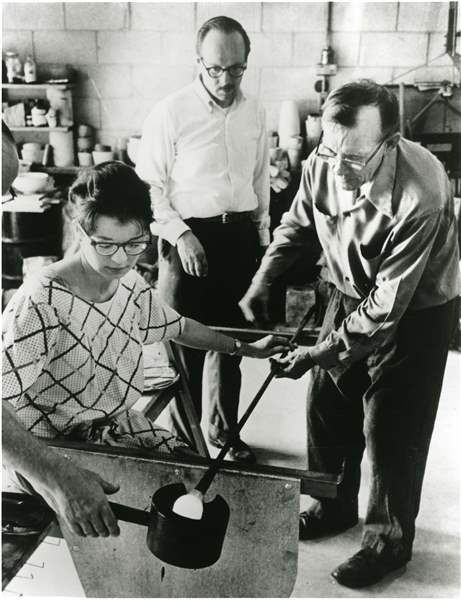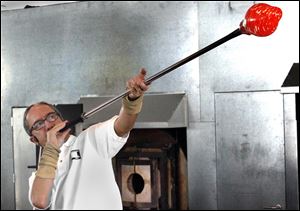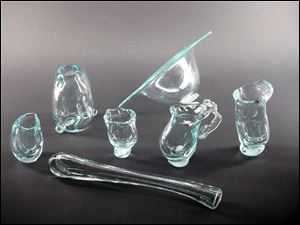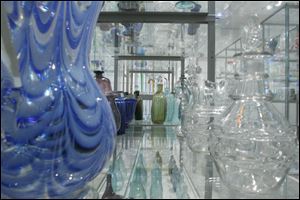
Glass art event set for Toledo
Glass Conference set for city where art form took root 50 years ago
5/13/2012
Rosemary Gulassa, Harvey Littleton, center, and Harvey Leafgreen take part in the 1962 glass art workshop at the Toledo Museum of Art.
Toledo Museum of Art

Leonard Marty, master instructor of glass at the Toledo Museum of Art, blows out a glass bulb during a demonstration at the museum's Glass Pavilion. The studio glass movement got its start 50 years ago at the museum.
The 1962 breakthrough in a Toledo garage was fortuitous happenstance: right people, right place, right time.
The result: For the first time, individuals were able to melt and form glass in small studio furnaces instead of in industrial furnaces. Moreover, during the next 10 years, the most important art genre to emerge in the latter half of the 20th century continued to be nurtured here.
RELATED ARTICLE:
"You can pin down the start of an international movement to one location and one moment. It started here and we should be very proud of it," said Jutta-Annette Page, curator of glass and decorative arts at the Toledo Museum of Art.
Fifty years later, art glass in brilliant hues will be served on sparkling platters when the Glass Art Society's annual conference convenes June 13 through 16, with activities centered in the museum, SeaGate Convention Centre, and the Park Inn. Expected are 1,200 GAS members: mostly artists but also gallery owners, collectors, museum curators, teachers, students, and toolmakers. They will attend sessions on the many techniques devised since 1962 for crafting glass, lectures, demonstrations, panel discussions, and tours.
The conference is to culminate with a huge party at the Huntington Center featuring a fashion show of wild and wacky glass attire.
'Emotional ties'
Many of the world's best glass artists, the first and second generations to work in the medium, will attend, Ms. Page said. They're the ones who -- through many a trial and error resulting in homely blobs of molten glass before they got it right -- are the early innovators: Fritz Dreisbach, Toots Zinsky, Dan Dailey, Daniel Schwoerer, Ginny Ruffner, Marvin Lipofsky, along with two who introduced the medium to eager Australian artists, Dick Marquis and Nick Mount. Also speaking will be the renowned Paul Stankard, who expresses natural-looking floral motifs in crystal paperweights, columns, and orbs that command prices in five figures.

Rosemary Gulassa, Harvey Littleton, center, and Harvey Leafgreen take part in the 1962 glass art workshop at the Toledo Museum of Art.
They'll discuss the genre's history, new parameters, future methods, global influences, and effective teaching. A film montage will feature the movement's Toledo beginnings.
"All of these artists who have played such an incredible role in the art are coming here. The emotional ties are here," said Ms. Page, adding that many of them passed through Toledo in those early years. She is vice president of the Glass Art Society.
Volunteers
A 28-foot-long truck from the Corning Museum of Glass in New York, fitted with a stage and fiery hot shops for melting glass, is to be inside SeaGate Centre for demos, and another is to be outside the Glass Pavilion. Lifetime achievement awards are to be given, and classes in various styles of glass making are to be available before and after the event. One evening in the near-downtown Schmidt/Messenger studio, a group of seasoned pros are to gather for an "old timers' blow."
"The community has come together for this conference like no other," said Pam Koss, executive director of GAS.
A large group of volunteers in the city's arts and business communities has been planning the event for nearly two years. Sponsors, led by Block Communications Inc., parent company of The Blade, have donated a total of $200,000, more than for any other GAS conference, Ms. Koss said.
"Toledo has embraced us in an all-encompassing way," she said.
Like most professional conferences, sessions will be limited to GAS members. But a blast of creative energy open to everybody will be the free Gallery Hop the evening of June 15, when four buses are to shuttle thousands of people to dozens of downtown and nearby studios and galleries bursting with glass, said Marc Folk, executive director of the Arts Commission of Greater Toledo.
"We've been working to make sure the mechanics of the [Gallery Hop] are notched up another level," he said.
In addition, many locations will host free demos and exhibitions on the June 13 Toledo Day of Glass and in the Detroit area on June 17.
Museum's role
As a primary venue, the museum is to be the site of the opening ceremony and reception, demos in the Glass Pavilion's hot shop, and lectures in the Peristyle and Little theaters. Brian Kennedy, museum director, is to deliver the keynote speech.

Jutta-Annette Page, curator of glass and decorative arts at the Toledo Museum of Art, says, ‘You can pin down the start of an international movement to one location and one moment. It started here and we should be very proud of it.'
Each of the five galleries in the Glass Pavilion and several of its glass "cavities" have been rearranged to display 80 percent of the museum's glass in new configurations, Ms. Page said.
The complete reinstallation is the first since the building opened in 2006, and the changes allow the pavilion's sun-shielding curtains to be open as was originally intended.
Of greatest import, the museum's new $3 million Wolfe Gallery for Contemporary Art is to open June 14 with an exhibit showing how glass eats color. Color Ignited: Glass 1962-2012, is to have 80 pieces celebrating the development of style, form, and the magnificent hues that glass can express as no other medium is able to.
In a beautiful new book named for the Color Ignited exhibit, Ms. Page writes: "Glass in its many manifestations promised brilliant color as glossy and saturated as that of wet paint can, but with greater luminosity and plasticity, both of which were yet uncharted for artistic expression."
This year's event, noted Mr. Folk, is a direct descendant of groundwork laid long ago.
"You're going to see what the impact is of a wholesale investment in a creative community," he said. "It's of major significance to the community."
Deep roots
In 1888, a 20-something Edward Drummond Libbey, enticed by an economic development package and abundant natural gas, moved his family's glass factory here from Massachusetts. Just 13 years later, he was successful enough to establish the Toledo Museum of Art with his wife, Florence Scott Libbey, and others. And into the 1920s, he sought out and purchased some of the world's best glass collections, donating them to the museum.

Seven glass vessels recently acquired by the Toledo Museum were created at the 1962 experimental workshop. The bowl and vessel at rear are by Tom McGlauchlin, a respected Toledo glass artist who died in 2011. The five objects in the foreground were created by Edith Franklin, a ceramicist now in her late 80s.
By the 1930s, a handful of isolated artists were experimenting with glass, which Harvey Littleton, a ceramics teacher at the University of Wisconsin, found fascinating. In the 1950s, he taught at the Toledo museum and got to know then-director Otto Wittmann. When he planned an exploratory glass workshop in 1962, Mr. Wittmann invited him to hold it in Toledo. It was the right place.
Among the dozen attendees were two local men who brought essential skills: Dominick Labino, a glass researcher at Johns Manville in Waterville and an art-glass hobbyist in his free time, and Harvey Leafgreen, who had worked for Libbey Glass, blowing experimental radar and television tubes.
Workshop participants built a small brick oven and installed a propane-fueled furnace but couldn't get it hot enough to melt glass. Mr. Labino suggested using green fiber glass marbles made by his employer, and to everyone's delight, they melted just enough to be malleable. And Mr. Leafgreen, 69, who had worked with traditional glass blowers as a youth in his native Sweden, showed them how to blow it. They created several simple greenish objects, some of which will be on view.
Mr. Littleton went on to establish a glass program at the University of Wisconsin, and his avid student Fritz Dreisbach became the first director of the Toledo museum's School of Art and Design in 1967.
Museum staff nurtured the nascent art by organizing exhibitions in 1966, 1968, 1970, and 1972 to showcase the fledgling medium.
Creative growth
Another rung in the ladder was a $500,000 gift from Harold Boeschtenstein, chairman of what was then Owens-Corning Fiberglas Corp. in 1970; it paid to construct a two-story gallery devoted to the museum's glass holdings. (That area is the site of the new Wolfe Gallery).

The Glass Pavilion has been rearranged to display 80 percent of the museum's collection and allow the building's sun-shielding curtains to be open as was originally intended.
"There's a solidity of the institution. The Toledo museum has always been a rock and always been supportive of glass," Ms. Page said.
During the GAS conference, more than 40 shops, including out-of-town galleries renting space locally, will sell glass from artists around the world.
Mr. Folk of the arts commission pointed out Toledo's creative growth with two ventures that have moved into empty buildings in the first block of North Huron Street in the Warehouse District: Gathered Art Gallery and Studios, which is to have a glass-making furnace, and Graphite Design + Build, the shop of two artists who make large-scale sculptural pieces for public spaces.
Most of the GAS events and sessions require membership as well as conference registration ($70 and $315 respectively) to attend, but there are free glass-making displays and exhibits (June 13), the sale of art and goblets (June 15 and 16), and the Gallery Hop the evening of June 15. To see the complete GAS schedule, go to glassart.org.
Contact Tahree Lane at: tlane@theblade.com and 419-724-6075.